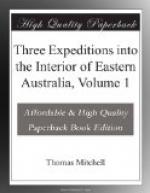CROSS IT WITH ONE MAN.
As soon as I had fixed on the camp I forded the river, accompanied by Woods carrying my rifle. The water where I crossed did not reach above the ankle, but the steepness of the banks on each side was a great obstacle to the passage of my horse. I proceeded due north, in search of rising ground, but the whole country seemed quite level. After crossing an open plain of about two miles in length, I entered a brush of Acacia pendula, and soon after I arrived at an old channel or hollow scooped out by floods.
PREVENTED BY A NATIVE WITH SPEARS FROM SHOOTING A KANGAROO.
As I approached a line of bushes I saw a kangaroo which sat looking at my horse until we were very near it, and I was asking Woods whether he thought we could manage to carry it back if I shot it; when my horse, suddenly pricking his ears, drew my attention to a native, apparently also intent on the kangaroo, and having two spears on his shoulder. On perceiving me he stood and stared for a moment, then taking one step back, and swinging his right arm in the air, he poised one of his spears, and stood stretched out in an attitude to throw. He was a tall man, covered with pipe-clay, and his position of defiance then, as he could never have before seen a horse, was manly enough. It was not prudent to retire at that moment, although I was most anxious to avoid a quarrel. I therefore galloped my horse at the native, which had the desired effect; for he immediately turned, and disappeared at a dog-trot among the bushes.
RE-CROSS THE RIVER.
By going forward I gained a convenient cover, which enabled me to retire upon the river without seeming to turn, as in fact I did, to avoid further collision with the natives at so great a distance from the party. The bed of the river was flat, and consisted of small pebbles, not much worn by attrition, and mixed with sand. Many dead trees lay in parts of the channel. The average breadth of the water was forty-five yards; the breadth from bank to bank seventy-two yards; and the perpendicular height of the banks above the water twenty-seven feet.




